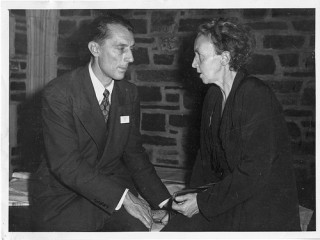
Frederic Joliot-Curie biography
Date of birth : 1900-03-19
Date of death : 1958-08-14
Birthplace : Paris, France
Nationality : French
Category : Science and Technology
Last modified : 2011-07-22
Credited as : Physicist, Nobel laureat,
Frédéric Joliot-Curie was born in Paris on March 19, 1900, the youngest of six children whose father had served in the militia of the Paris Commune 30 years earlier. While a student of Paul Langevin at the School of Physics and Chemistry in Paris, he received in 1925 an assistantship at the laboratory of the Radium Institute of Marie Curie, the discoverer of radioactivity. There he met and the next year married Irene Curie, the elder daughter of Madame Curie, who pursued her research at her mother's laboratory, and added his wife's surname to his own.
The union of Irene and Frederic constituted in the history of science an outstanding example of husband-wife teamwork. Among the 26 papers published jointly by the Joliot-Curies during the first 10 years of their partnership was the 1932 paper announcing a penetrating radiation from beryllium when bombarded with alpha rays. In a 1934 paper they disclosed their greatest discovery, the artificial production of radioactive elements. They achieved this by bombarding certain light elements, such as aluminum, boron, and magnesium, with alpha radiation. The significance of this discovery was that it allowed scientists to study more systematically the patterns of nuclear transformations. For this achievement they received the Nobel Prize in chemistry in 1935.
Two years later Joliot-Curie, as newly appointed professor at the Collège de France, launched the development of a research center in nuclear physics. He and his collaborators established for the first time that approximately three fast neutrons were produced when a uranium atom was fissioned by slow neutrons. From this they concluded shortly afterward that a chain reaction in uranium was a distinct possibility.
After World War II Joliot-Curie's scientific activity largely concerned the reorganization of French atomic and nuclear research. At his recommendation the French government set up the Commissariat i l'energie Atomique, on which Joliot-Curie served as high commissioner. He had to resign from this post in 1950 because of his most vocal advocacy of the aims and policies of the French Communist party, of which he had been a member since 1942. His last 8 years were spent in directing research at the Centre National de la Recherche Scientifique and at the College de France, where during his tenure he offered 13 different courses in advanced physics. Upon the death of his wife in 1956, Joliot-Curie succeeded her as the director of the Curie Laboratory of the Radium Institute. His last contribution to the cause of French science, a new and large nuclear research center at Orsay, had just become operational when he died in Paris on Aug. 14, 1958.
















